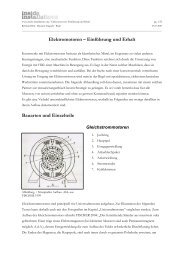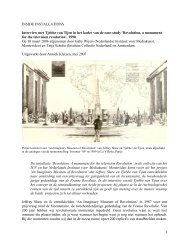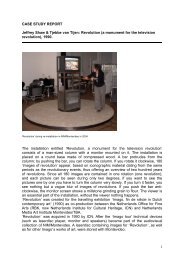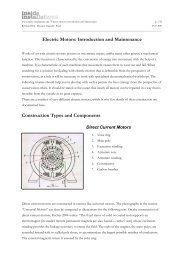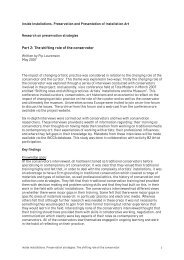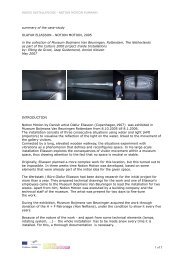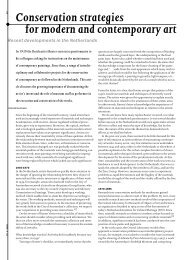GLOSSARY OF LIGHT TECHNOLOGY - Inside Installations
GLOSSARY OF LIGHT TECHNOLOGY - Inside Installations
GLOSSARY OF LIGHT TECHNOLOGY - Inside Installations
Create successful ePaper yourself
Turn your PDF publications into a flip-book with our unique Google optimized e-Paper software.
WWW.INSIDE-INSTALLATIONS.ORG <strong>GLOSSARY</strong> <strong>OF</strong> <strong>LIGHT</strong> <strong>TECHNOLOGY</strong> FRANZISKA HERZOG ZKM KARLSRUHE 06<br />
Bayonet|B Bases<br />
cont.<br />
Bimetallic Relays<br />
Blended Lamps<br />
Cable<br />
Cable|K Bases<br />
(Y bases)<br />
Candela<br />
Pins fastened to the base provide a secure seat for the illuminant in<br />
the > holder. The positioning of the pins and the diameter of the base<br />
prevent the installation of the wrong illuminant.<br />
BA9s and B15d are typical markings (> base descriptions).<br />
Bayonet|B bases are found e.g. in high voltage halogen lamps.<br />
are > relays which are activated by thermally active components called<br />
bimetallic strips. These strips consist of two different metals and<br />
change form based on the effect of temperature due to their different<br />
heat expansion coefficients. Applying a current leads to a warming of<br />
the bimetallic strips and finally to deformation. When a defined, predetermined<br />
temperature is reached, a switching mechanism shuts off.<br />
Bimetallic relays are used for control applications and switching<br />
processes.<br />
In light technology for example, bimetallic relays can be built into ><br />
incandescent lamps where they are positioned near the filament. After<br />
a short heating-up period, the light begins to blink. This heating-up<br />
leads to an interruption in the current flow and cooling-down causes<br />
the re-closing of the current flow and thereby the illumination of the<br />
lamp.<br />
are a combination of > thermal radiators and > gas discharge lamps,<br />
more precisely a combination of > incandescent lamps and > high<br />
pressure mercury vapour lamps.<br />
The construction of blended lamps is similar to that of high pressure<br />
mercury vapour lamps. Because the current limiting is secured by a<br />
special tungsten filament which surrounds the discharge chamber i.e.<br />
burner, a > ballast is not needed for operation. The outer bulb is<br />
coated with a > phosphor just like in high pressure mercury vapour<br />
lamps.<br />
Blended lamps have the following characteristics.<br />
They have a relatively higher > light output than incandescent<br />
lamps whereby the > light colour changes from yellow|reddish towards<br />
bluish|white after a particular burning-in period. For complete<br />
>luminous flux rendering a start-up time of approximately 2 min is<br />
required. Immediate reignition after a power failure of < 10ms is<br />
possible, otherwise a cooling time of 5-10min is necessary. The<br />
average lifetime is 5,000h. The > power is 160-500W.<br />
The most common constructions are the standard form (> incandescent<br />
lamp) and the ellipsoid form. The > screw|E base is most prominent. A<br />
precise classification of blended lamps is provided by > ILCOS 1231 or<br />
the particular > lamp manufacturers.<br />
Similar to incandescent lamps, blended lamps are operated with mains<br />
voltage (230V). The > dimming of the lamps is possible.<br />
describes the bundling of several > flexes, i.e. single insulated<br />
wires, which are held together by an additional insulation, the cable<br />
sheath.<br />
The purpose of an electric cable is to minimise the loss of the current<br />
flow in the energy supply.<br />
For > direct current the wire insulation (> wire) is red and black.<br />
For > alternating current brown|black is used for the > live conductor<br />
and blue for the > neutral conductor. The > protective earth conductor<br />
has a green-yellow wire insulation. For > heavy current there is a<br />
blue|previously grey > neutral conductor, and one each of a black,<br />
grey and brown > live conductors. For > high voltage, single wire<br />
cables are mostly used.<br />
Wire insulation and cable sheaths are manufactured from various<br />
plastics according to need e.g. from polyvinylchloride (PVC),<br />
polyethylene (PE), Teflon (PTFE), rubber (when mechanically stressed)<br />
or silicon (when thermally stressed).<br />
Cable manufacture is subject to standardisation through the > IEC.<br />
are single ended and|or double ended > lamp > bases.<br />
The electrical connection is made with a cable provided with terminals<br />
separate from the > holder, which in this way allows a better and safer<br />
electrical connection.<br />
Cable|K bases can be used for lamps with a high > power.<br />
Typical descriptions are K24s, K39d (> base descriptions).<br />
Cable|K bases are found e.g. in double ended > gas discharge lamps<br />
with more than 6,000W power.<br />
is the unit of measurement for > luminous intensity.<br />
It describes the > luminous flux of a > light source in a particular<br />
solid angle. It is measured in Candela (cd).



